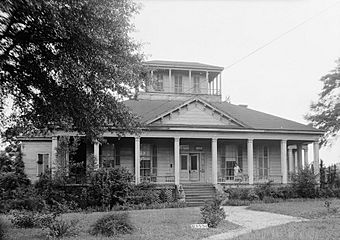Cato House facts for kids
Quick facts for kids |
|
|
Cato House
|
|

The Cato House in 2008
|
|
| Lua error in Module:Location_map at line 420: attempt to index field 'wikibase' (a nil value). | |
| Location | 823 W. Barbour St., Eufaula, Alabama |
|---|---|
| Area | 0.1 acres (0.040 ha) |
| Built | 1858 |
| NRHP reference No. | 71000094 |
| Added to NRHP | May 27, 1971 |
The Cato House is a historic home built in 1858 in Eufaula, Alabama. It was built for Lewis Llewellen Cato, who was a lawyer and an important leader in the movement for Southern states to leave the United States. This one-story house was built using the labor of enslaved people.
The front of the house has a wide porch with a special triangular part, called a pediment, above the main double doors. Inside, a central hallway leads to a dining room. On either side of the hall are parlors (living rooms) and the main bedroom. More rooms are located at the back of the house. The roof is gently sloped and has a small, decorative room on top, which also has a tiny porch around it.
The Cato House became a part of the National Register of Historic Places on May 27, 1971. This means it is recognized as an important historical site.
Contents
History of the Cato House
The land where the Cato House stands was originally bought from the Creek Native American people. The Cato family has owned this house for most of its history. Lewis Llewellen Cato, the first owner, moved to Barbour County, Alabama in 1837. He was born in Hancock County, Georgia.
Lewis Cato was a very important person in Barbour County. He worked very hard as a lawyer and was known for his good advice. From 1861 to 1865, he served as a representative for the county in the state senate. He passed away on December 4, 1868.
A Place for Important Meetings
The Cato House is famous for being the place where many important meetings about states' rights were held between 1858 and 1860. A group of lawyers and politicians, known as the Eufaula Regency, met here often. These meetings helped to start groups called Southern Rights Clubs. These clubs were guided by a leader named William Lowndes Yancey.
Lewis Llewellen Cato, who was called "the great secessionist" in Alabama, was a friend of Yancey. He was also a key member of the Eufaula Regency. These groups discussed the idea of Southern states separating from the United States.
The Cato House was also the site of a big celebration when Alabama decided to leave the Union. A historian named Lewy Dorman wrote that the most important steps toward secession came from the leaders in Southeast Alabama, especially the Eufaula Regency. He said they were the most consistent supporters of states leaving the Union.
Later Owners of the House
After Lewis L. Cato died, the house was sold to E. B. Young. However, in 1905, Dr. Julius Cato, who was Lewis L.'s son, bought the house back. Miss Annie Cato, Lewis L.'s granddaughter, lived in the house until 1997. Today, Jeff Thorne owns the house.
The Cato House is a popular spot during the Eufaula Pilgrimage. This is an event held every year where people can tour historic and beautiful houses in Eufaula. It is organized by the Eufaula Heritage Association.
See also
 In Spanish: Casa Cato para niños
In Spanish: Casa Cato para niños

